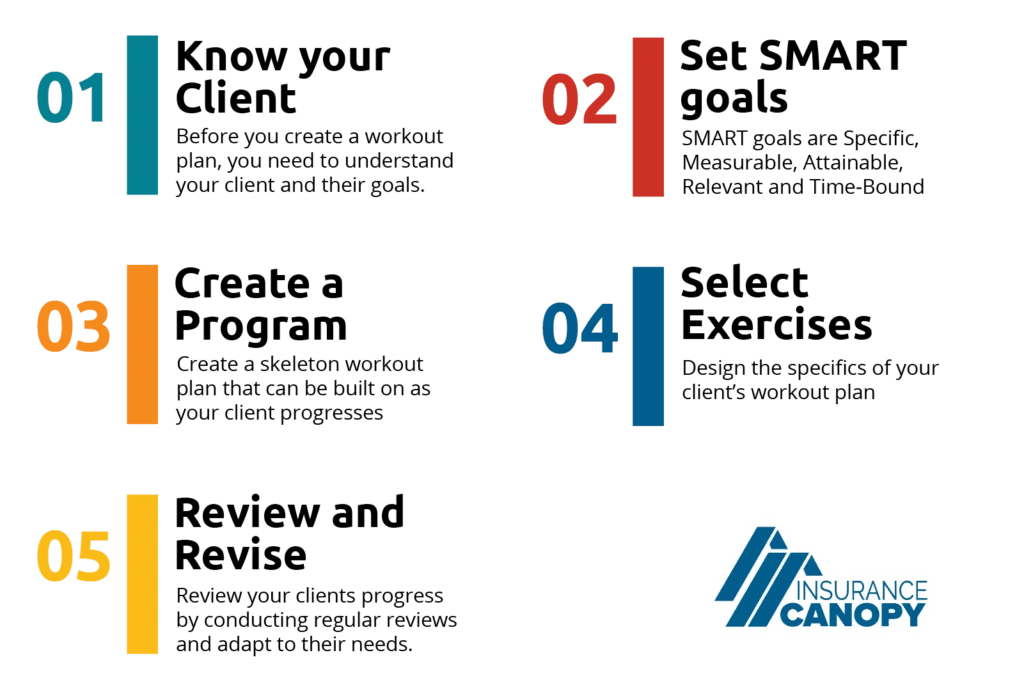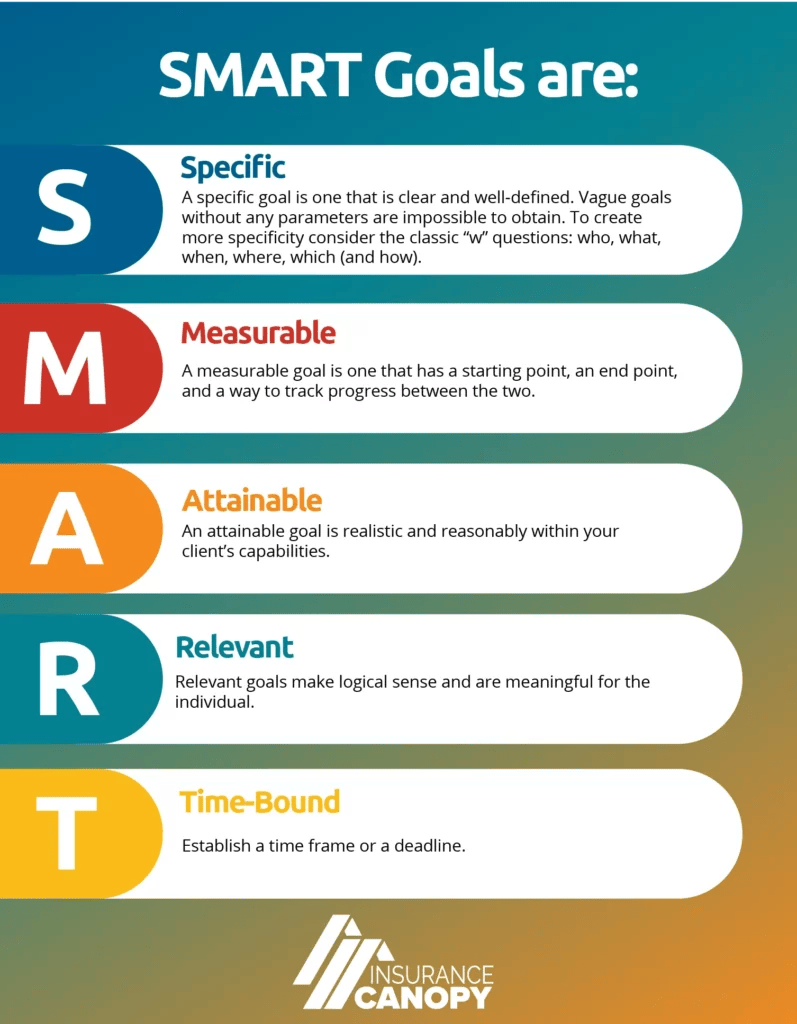- Last Updated:
- 2/26/2025
- Chelsea Ramsey, ACE CPT
You’ve never done a marathon, or even a half marathon before, but one day you decide you want to compete in the Boston Marathon.
Do you show up to the start line on the third Monday of April and wing it? Or do you find out your 5k time first and figure out what you’d need to do to make the qualifying time?
You already know from experience that no matter the goal, a game plan is necessary to make sure your client can achieve it. Workout plans help you create this roadmap by establishing your client’s starting point and an idea of how to get them from Point A to Point B.
Designing a workout plan for clients involves five primary steps.

Copy your free customizable workout template here.
1. Know Your Client
Before you can effectively create a workout plan, you need to understand your client and their goals.
Understanding the client involves more than just their basic goal or medical history. Of course, those things are still important, but gathering a little extra information will help you craft a more efficient, relevant, and results-producing plan!
Beyond the main goal your client gives you, dig a little deeper. Ask them things like:
- Why is this their goal?
- If they want to lose weight, is it so they can keep up with their kids better? For medical reasons? Because they want to feel better??
- Have they tried to accomplish this goal before?
- When?
- How successful were you?
- What worked well for you and what didn’t?
- What kind of fitness experience do they have?
- Did they participate in school sports?
- What type of workouts do they already do?
- What kinds of experiences with fitness do they have?
- Have they worked with a trainer before? What did they like/dislike about their previous experience?
- What are the positives or negatives of their previous experiences?
- What sorts of activities do they enjoy?
These more detailed questions help you design a workout plan that is relevant and enjoyable for your client. The more they enjoy their workouts, the more likely they are to stay consistent, which increases their chances of actually achieving their fitness goals.
In addition to these “whys,” it’s important to know the more objective, practical information.
- Current fitness level
- Health history
- Injury history
- Overall lifestyle
These things provide you with the necessary information to design a workout program that is safe for your client to perform and meets the client where they are now, both physically and in terms of their current daily routine.
2. Set SMART Goals
Clients may come to you with a goal already in mind. Oftentimes, though, it’s something general like “lose weight,” “learn to use the machines,” or “get stronger.”
In those cases you can use the information you uncovered in your earlier questioning to help your client set smarter (more likely to succeed) goals.

Example:
- Good: “I want to lose weight.”
Too vague and open-ended. - Better: “I want to lose 10lbs.”
There’s a specific and measurable task but no timeline or motivation. - Best: “I want to lose 10lbs for my friend’s wedding in three months by losing 1-2lbs per week for 12 weeks.”
- There is a specific and measurable goal to track, with a definitive deadline, relevant motivation, and a realistic, logical progress expectation.
It can be a challenge for anyone to stay consistent with training if the goalposts keep moving or don’t exist at all. That’s why SMART goal setting is essential when designing a workout plan for clients.
Set Expectations
Realistic, attainable expectations while goal-setting is another important part of building a workout plan. Many clients can start to feel discouraged to the point of giving up if they don’t see “enough results” fast enough, so transparency is key. Review concepts like:
- Realistic timelines: Change won’t be obvious overnight, so be clear about how long it may take to reach their main goal while maintaining a positive outlook. Prepare for potential setbacks by reviewing what they could be and how to handle them if/when they arise.
- Progress goals: Set benchmarks to shoot for along the way to their primary goal to maintain motivation. Short-term goals create a sense of accomplishment and make long-term goals feel more attainable.
- Examples: Provide examples of what they can expect to feel and see at specific intervals – like how they might feel jeans fit better before “seeing” results or how the number on the scale might not change much because while they are losing fat, they are also building muscle.
- Commitment and consistency: Meaningful change takes consistency and time. Since you can’t be with clients every day, make sure they know what they need to do on their own to get their results.
3. Create an Outline/Template
Once you know your client’s starting point and goals, you can create a skeleton workout plan.
You will build on this base plan as your client progresses. This stage is for figuring out the overall structure of your program and includes:
- Frequency: How often you meet with the client and how often they train on their own (if applicable).
- Intensity: How “hard” the workouts will be and how you’ll scale them with the client’s progress.
- Time: How long each workout takes and how long the overall program will last to reach the client’s starting goal.
- Type: What kind of activities or workouts they’ll do, like weightlifting, conditioning, circuits, etc.
4. Select Exercises and Exercise Volume
After you’ve set a goal and created an outline, you can start designing the specifics of your client’s workout plan. Include details like:
- Workout structures – supersets, circuits, muscle group splits, etc.
- Individual exercises
- Warm-ups
- Stretching/cool-downs
- Rep ranges
- Tempos
- Sets
- Rests
- Progression/progressive overload week to week
Pro Tip: Keep your client’s unique needs and goals in mind when creating their plan. Factor in medical needs, physical limitations, and any restrictions that could impact them.
5. Review and Update Regularly
Review and evaluate your client’s progress and general feedback at regular intervals. You can conduct reviews weekly, biweekly, monthly, or whenever it makes sense for your client and their advancement.
Your client’s capabilities may change, they may experience a setback, or they might just not enjoy something about the program. These things happen, and that’s okay!
Trainers need to adapt on the fly all the time, so remember to remain flexible with the plan and update exercises and workouts as needed.
6. (Bonus!) Protect Yourself with Liability Insurance
Creating an effective and enjoyable workout plan for your clients takes a lot of time, effort, and attention to detail. But, even with the most meticulous planning, accidents can still happen.
Fitness-related accidents, injuries, and other damages can lead to expensive medical bills or even lawsuits like these. To help protect yourself and your business from the costs of potential claims, you need personal trainer liability insurance.
FAQs About Designing Custom Workout Plans
How Do I Balance Effectiveness and Safety in a Client’s Workout Plan?
- Conduct health history questionnaires, fitness assessments, and movement screenings with new clients before beginning a workout program. These things should help you identify potential safety risks in terms of the client’s health and fitness status.
- Form first, always. Make sure a client can move safely through the movements of your planned exercises before adding weight or resistance.
- Avoid increasing the resistance until the client can perform the exercise correctly and with relative ease at the current level.
- When in doubt, have the client complete the modified version of an exercise before moving to a more advanced or challenging version.
- Monitor your client’s rate of perceived exertion, breathing patterns, and overall apparent fatigue to prevent over-exertion.
- Conduct regular safety and risk assessments in your training space.
What Documentation Should I Keep When Designing Workout Plans for Clients?
Before starting a workout program:
- Health history forms
- Liability waivers
- Fitness assessments
- Movement screenings
- Contraindications (conditions or reasons a particular exercise or kinds of exercise should be avoided, like those with diastasis recti should not perform sit-ups)
During training programs:
- Goals and/or progress sheet(s)
- Daily or weekly workout plans
- Client’s performance during each workout (weight used, reps completed, etc.)
- Movements that aggravate previous issues or cause pain beyond general fatigue “pain”
- Exercises the client enjoys
How Do I Tailor a Workout Plan to a Client’s Specific Goals?
- Evaluate their current fitness level
- Establish their desired goals
- Assign exercises that fit their preferences and limitations
- Remember the SAID principle: Specific Adaptation to Imposed Demands (meaning the body will adapt to the demands placed on it, so train the muscles and skills most relevant to the client’s goals)

Chelsea Ramsey, ACE CPT | Copywriter
Ohio-based copywriter and licensed insurance agent Chelsea Ramsey leverages her experiences as an American Council on Exercise (ACE) certified personal trainer, a role-playing game writer, and a former auto claims adjuster. She holds a bachelor’s in English from Ohio State University and a TEFL certification from Oxford Seminars. Before working at Veracity, Chelsea wrote for Zulily and trained clients at her local community center. She now writes to assist fitness professionals and entertainers in finding their ideal insurance policies.
Ohio-based copywriter and licensed insurance agent Chelsea Ramsey leverages her experiences as an American Council on Exercise (ACE) certified personal trainer, a role-playing game writer, and a former auto claims adjuster. She holds a bachelor’s in English from Ohio State University and a TEFL certification from Oxford Seminars. Before working at Veracity, Chelsea wrote for Zulily and trained clients at her local community center. She now writes to assist fitness professionals and entertainers in finding their ideal insurance policies.





